Shrub
This articleneeds additional citations forverification.(October 2018) |
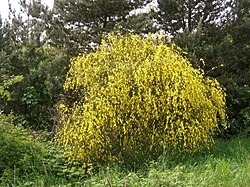
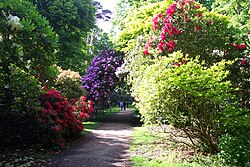
Ashruborbushis a small-to-medium-sizedperennialwoody plant.Unlikeherbaceous plants,shrubs have persistent woody stems above the ground. Shrubs can be either deciduous or evergreen. They are distinguished fromtreesby their multiplestemsand shorterheight,less than 6–10 m (20–33 ft) tall.[1][2]Small shrubs, less than 2 m (6.6 ft) tall are sometimes termed assubshrubs.Manybotanical groupshave species that are shrubs, and others that are trees and herbaceous plants instead.
Some define a shrub as less than 6 m (20 ft) and a tree as over 6 m. Others use 10 m (33 ft) as the cutoff point for classification.[2]Many trees do not reach this mature height because of hostile, less than ideal growing conditions, and resemble shrub-sized plants. Others in such species have the potential to grow taller in ideal conditions. For longevity, most shrubs are classified betweenperennialsand trees. Some only last about five years in good conditions. Others, usually larger and more woody, live beyond 70. On average, they die after eight years.[3]
Shrublandis the natural landscape dominated by various shrubs; there are many distinct types around the world, includingfynbos,maquis,shrub-steppe,shrub swampandmoorland.In gardens and parks, an area largely dedicated to shrubs (now somewhat less fashionable than a century ago) is called ashrubbery,shrub border or shrub garden. There are many gardencultivarsof shrubs, bred for flowering, for examplerhododendrons,and sometimes even leaf colour or shape.
Compared to trees and herbaceous plants, a small number of shrubs have culinary usage.[citation needed]Apart from the severalberry-bearing species (using the culinary rather than botanical definition), few are eaten directly, and they are generally too small for muchtimberuse unlike trees. Those that are used include several perfumed species such aslavenderandrose,and a wide range of plants with medicinal uses.Teaandcoffeeare on the tree-shrub boundary;[4]they are normally harvested from shrub-sized plants, but these would be large enough to become small trees if left to grow instead.
Definition[edit]
Shrubs are perennial woody plants, and therefore have persistent woodystemsabove ground (compare with succulent stems ofherbaceous plants).[2]Usually, shrubs are distinguished from trees by their height and multiple stems. Some shrubs aredeciduous(e.g.hawthorn) and othersevergreen(e.g.holly).[2]Ancient GreekphilosopherTheophrastusdivided the plant world into trees, shrubs and herbs.[5]
Small, low shrubs, generally less than 2 m (6.6 ft) tall, such aslavender,periwinkleand most small garden varieties ofrose,are often termed assubshrubs.[6][7]
Most definitions characterize shrubs as possessing multiple stems with no main trunk below.[2]This is because the stems have branched below ground level. There are exceptions to this, with some shrubs having main trunks, but these tend to be very short and divide into multiple stems close to ground level without a reasonable length beforehand. Many trees can grow in multiple stemmed forms also while being tall enough to be trees, such asoakorash.[2]
Use in gardens and parks[edit]
An area ofcultivatedshrubs in aparkor agardenis known as ashrubbery.[8]When clipped astopiary,suitable species or varieties of shrubs develop densefoliageand many small leafybranchesgrowing close together.[9]Many shrubs respond well to renewalpruning,in which hard cutting back to a "stool",removes everything but vital parts of the plant, resulting in long new stems known as" canes ".[10]Other shrubs respond better to selective pruning to dead or unhealthy, or otherwise unattractive parts to reveal their structure and character.[11]
Shrubs in common garden practice are generally consideredbroad-leaved plants,though some smallerconiferssuch asmountain pineandcommon juniperare also shrubby in structure. Species that grow into a shrubby habit may be eitherdeciduousorevergreen.[12]
Botanical structure[edit]
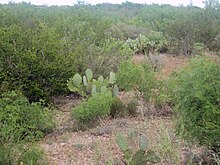

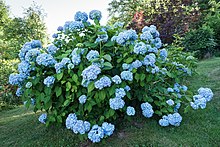
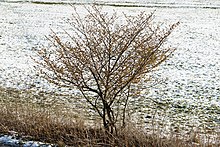

Inbotanyandecology,a shrub is more specifically used to describe the particularphysical canopy structureorplant life-formof woody plants which are less than 8 metres (26 ft) high and usually multiple stems arising at or near the surface of the ground. For example, a descriptive system widely adopted inAustraliais based on structural characteristics based on life-form, plus the height and amount of foliage cover of the tallest layer ordominantspecies.[13]
For shrubs that are 2–8 metres (6.6–26.2 ft) high, the following structural forms are categorized:
- dense foliage cover (70–100%) —closed-shrubs
- mid-dense foliage cover (30–70%) —open-shrubs
- sparse foliage cover (10–30%) —tall shrubland
- very sparse foliage cover (<10%) —tall open shrubland
For shrubs less than 2 metres (6.6 ft) high, the following structural forms are categorized:
- dense foliage cover (70–100%) —closed-heathorclosed low shrubland—(North America)
- mid-dense foliage cover (30–70%) —open-heathormid-dense low shrubland—(North America)
- sparse foliage cover (10–30%) —low shrubland
- very sparse foliage cover (<10%) —low open shrubland
List[edit]
Those marked with * can also develop into tree form if in ideal conditions.
- A
- Abelia(Abelia)
- Acer(Maple) *
- Actinidia(Actinidia)
- Aloe(Aloe)
- Aralia(Angelica Tree,Hercules' Club) *
- Arctostaphylos(Bearberry,Manzanita) *
- Aronia(Chokeberry)
- Artemisia(Sagebrush)
- Aucuba(Aucuba)
- B
- Berberis(Barberry)
- Bougainvillea(Bougainvillea)
- Brugmansia(Angel's trumpet)
- Buddleja(Butterfly bush)
- Buxus(Box) *
- C
- Calia(Mescalbean)
- Callicarpa(Beautyberry) *
- Callistemon(Bottlebrush) *
- Calluna(Heather)
- Calycanthus(Sweetshrub)
- Camellia(Camellia,Tea) *
- Caragana(Pea-tree) *
- Carpenteria(Carpenteria)
- Caryopteris(Blue Spiraea)
- Cassiope(Moss-heather)
- Ceanothus(Ceanothus) *
- Celastrus(Staff vine) *
- Ceratostigma(Hardy Plumbago)
- Cercocarpus(Mountain-mahogany) *
- Chaenomeles(Japanese Quince)
- Chamaebatiaria(Fernbush)
- Chamaedaphne(Leatherleaf)
- Chimonanthus(Wintersweet)
- Chionanthus(Fringe-tree) *
- Choisya(Mexican-orange Blossom) *
- Cistus(Rockrose)
- Clerodendrum(Clerodendrum)
- Clethra(Summersweet, Pepperbush) *
- Clianthus(Glory Pea)
- Colletia(Colletia)
- Colutea(Bladder Senna)
- Comptonia(Sweetfern)
- Cornus(Dogwood) *
- Corylopsis(Winter-hazel) *
- Cotinus(Smoketree) *
- Cotoneaster(Cotoneaster) *
- Cowania(Cliffrose)
- Crataegus(Hawthorn) *
- Crinodendron(Crinodendron) *
- Cytisusand allied genera (Broom) *
- D
- Daboecia(Heath)
- Danae(Alexandrian laurel)
- Daphne(Daphne)
- Decaisnea(Decaisnea)
- Dasiphora(Shrubby Cinquefoil)
- Dendromecon(Tree poppy)
- Desfontainea(Desfontainea)
- Deutzia(Deutzia)
- Diervilla(Bush honeysuckle)
- Dipelta(Dipelta)
- Dirca(Leatherwood)
- Dracaena(Dragon tree) *
- Drimys(Winter's Bark) *
- Dryas(Mountain Avens)
- E
- Edgeworthia(Paper Bush) *
- Elaeagnus(Elaeagnus) *
- Embothrium(Chilean Firebush) *
- Empetrum(Crowberry)
- Enkianthus(Pagoda Bush)
- Ephedra(Ephedra)
- Epigaea(Trailing Arbutus)
- Erica(Heath)
- Eriobotrya(Loquat) *
- Escallonia(Escallonia)
- Eucryphia(Eucryphia) *
- Euonymus(Spindle) *
- Exochorda(Pearl Bush)
- F
- Fabiana(Fabiana)
- Fallugia(Apache Plume)
- Fatsia(Fatsia)
- Forsythia(Forsythia)
- Fothergilla(Fothergilla)
- Franklinia(Franklinia) *
- Fremontodendron(Flannelbush)
- Fuchsia(Fuchsia) *
- G
- Garrya(Silk-tassel) *
- Gaultheria(Salal)
- Gaylussacia(Huckleberry)
- Genista(Broom) *
- Gordonia(Loblolly-bay) *
- Grevillea(Grevillea)
- Griselinia(Griselinia) *
- H
- Hakea(Hakea) *
- Halesia(Silverbell) *
- Halimium(Rockrose)
- Hamamelis(Witch-hazel) *
- Hebe(Hebe)
- Hedera(Ivy)
- Helianthemum(Rockrose)
- Hibiscus(Hibiscus) *
- Hippophae(Sea-buckthorn) *
- Hoheria(Lacebark) *
- Holodiscus(Creambush)
- Hudsonia(Hudsonia)
- Hydrangea(Hydrangea)
- Hypericum(Rose of Sharon)
- Hyssopus(Hyssop)
- I
- Ilex(Holly) *
- Illicium(Star Anise) *
- Indigofera(Indigo)
- Itea(Sweetspire)
- J
- K
- Kalmia(Mountain-laurel)
- Kerria(Kerria)
- Kolkwitzia(Beauty-bush)
- L
- Lagerstroemia(Crape-myrtle) *
- Lapageria(Copihue)
- Lantana(Lantana)
- Lavandula(Lavender)
- Lavatera(Tree Mallow)
- Ledum(Ledum)
- Leitneria(Corkwood) *
- Lespedeza(Bush Clover) *
- Leptospermum(Manuka) *
- Leucothoe(Doghobble)
- Leycesteria(Leycesteria)
- Ligustrum(Privet) *
- Lindera(Spicebush) *
- Linnaea(Twinflower)
- Lonicera(Honeysuckle)
- Lupinus(Tree Lupin)
- Lycium(Boxthorn)
- M
- Magnolia(Magnolia)
- Mahonia(Mahonia)
- Malpighia(Acerola)
- Menispermum(Moonseed)
- Menziesia(Menziesia)
- Mespilus(Medlar) *
- Microcachrys(Microcachrys)
- Myrica(Bayberry) *
- Myricaria(Myricaria)
- Myrtusand allied genera (Myrtle) *
- N
- O
- P
- Pachysandra(Pachysandra)
- Paeonia(Tree-peony)
- Persoonia(Geebungs)
- Philadelphus(Mock orange) *
- Phlomis(Jerusalem Sage)
- Photinia(Photinia) *
- Physocarpus(Ninebark) *
- Pieris(Pieris)
- Pistacia(Pistachio,Mastic) *
- Pittosporum(Pittosporum) *
- Plumbago(Leadwort)
- Polygala(Milkwort)
- Poncirus*
- Prunus(Cherry) *
- Purshia(Antelope Bush)
- Pyracantha(Firethorn)
- Q
- R
- Rhamnus(Buckthorn) *
- Rhododendron(Rhododendron,Azalea) *
- Rhus(Sumac) *
- Ribes(Currant, Gooseberry)
- Romneya(Tree poppy)
- Rosa(Rose)
- Rosmarinus(Rosemary)
- Rubus(Bramble,Raspberry,Salmonberry,Wineberry)
- Ruta(Rue)
- S
- Sabia*
- Salix(Willow) *
- Salvia(Sage)
- Sambucus(Elder) *
- Santolina(Lavender Cotton)
- Sapindus(Soapberry) *
- Senecio(Senecio)
- Simmondsia(Jojoba)
- Skimmia(Skimmia)
- Smilax(Smilax)
- Sophora(Kōwhai) *
- Sorbaria(Sorbaria)
- Spartium(Spanish Broom)
- Spiraea(Spiraea) *
- Staphylea(Bladdernut) *
- Stephanandra(Stephanandra)
- Styrax*
- Symphoricarpos(Snowberry)
- Syringa(Lilac) *
- T
- Tamarix(Tamarix) *
- Taxus(Yew) *
- Telopea(Waratah) *
- Thujacvs. (Arborvitae) *
- Thymelaea
- Thymus(Thyme)
- Trochodendron*
- U
- Ulex(Gorse)
- Ulmus pumila celer(Turkestan elm – Wonder Hedge)
- Ungnadia(Mexican Buckeye)
- V
- Vaccinium(Bilberry,Blueberry,Cranberry)
- Verbesina centroboyacana
- Verbena(Vervain)
- Viburnum(Viburnum) *
- Vinca(Periwinkle)
- Viscum(Mistletoe)
- W
- Weigela(Weigela)
- X
- Xanthoceras
- Xanthorhiza(Yellowroot)
- Xylosma
- Y
- Yucca(Yucca,Joshua tree) *
- Z
References[edit]
- ^Lawrence, Anna; Hawthorne, William (2006).Plant Identification: Creating User-friendly Field Guides for Biodiversity Management.Routledge. pp. 138–.ISBN978-1-84407-079-4.
- ^abcdefAllaby, Michael (2019).A dictionary of plant sciences.Oxford Oxford University Press.ISBN9780198833338.OCLC1097073225.
- ^"Life Spans of Small Trees and Shrubs".McCabe's Landscape Construction.2014-02-27.Retrieved2022-04-29.
- ^Clayton, Liz (20 October 2021)."Is The Coffee Plant A Tree, Bush, Or Shrub?".sprudge.com.Retrieved2022-04-29.
- ^Bremness, Lesley (1994).The complete book of herbs.Viking Studio Books. p. 8.ISBN9780140238020.
- ^Fischer, Peggy (1990).Essential shrubs: the 100 best for design and cultivation.Friedman/Fairfax Publishers. pp. 9–.ISBN978-1-56799-319-6.
... Examples of subshrubs include candytuft, lavender, and rosemary. These broad definitions are...
- ^"What is a Subshrub?".World of Flowering Plants.2017-05-15.Retrieved2022-04-29.
- ^Whitefield, Patrick (2002).How to Make a Forest Garden.Permanent Publications. pp. 113–.ISBN978-1-85623-008-7.
- ^Varkulevicius, Jane (17 May 2010).Pruning for Flowers and Fruit.Csiro Publishing.ISBN9780643101975.Retrieved19 December2017– via Google Books.
- ^"Rejuvenation or Renewal Pruning to Restore Overgrown Shrubs".Organic Plant Care LLC | Organic Lawn & Plant Health Service in Hunterdon, Morris, Somerset & Union Counties, NJ and Bucks County, PA.2019-02-21.Retrieved2022-04-29.
- ^Turpin, Jason (2018-08-29)."What is Selective Tree and Shrub Pruning-How to Prune Correctly!".Turpin Landscape Design/Build.Retrieved2022-04-29.
- ^Elliott, Franklin Reuben (1 November 2008).Popular Deciduous and Evergreen Trees and Shrubs.Applewood Books.ISBN9781429012904.Retrieved19 December2017– via Google Books.
- ^Chris Paul (2024).The Best Evergreen Shrubs for Front Yards.Shrubs Radar, a website all about shrubs.
